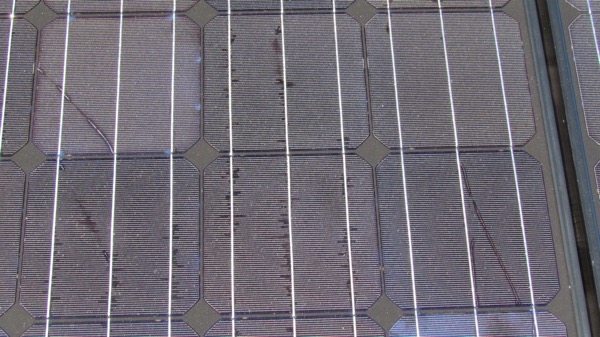As we gain about 5 minutes of daylight each day, and teeter on the edge of official drought conditions, we’re seeing a sharp increase in the amount of power generated by our solar array.
Almost every day we get strong sunshine directly on the panels. That has me assessing the array’s current status.

The solar array basks in the spring sunshine. The wind generator goes unused (Photo: Mark A. Zeiger)
We installed the current solar array almost 4 years ago (see Power Shift: Increasing Our Energy Independence)! I lose sight of that a lot, because I equate that install with the installation of the nickel-iron battery, less than a year ago (see Homestead Going Dark for Summer Solstice.)
Considering the conditions these panels have weathered since installation, they’re not doing too badly. I notice flaws in them now, which I assume must have come from cleaning snow off of them. My footing at the base of the rock wall often becomes precarious in icy conditions. I’m sure I’ve fallen against the panels a time or two, or an over-enthusiastic whack to break up glaze ice on a particularly cold day might have created them.
They look like cracks in the glass, but they don’t seem to be. I can’t feel the break running a finger over them.
I’m not happy about the flaws, but they don’t seem to have diminished the array’s output.
Any material on solar panels shows graphs indicating diminishing power production over time. Officially, solar panels start out at top productivity, then produce less power over time, eventually leveling off.
Unofficially, solar panels can produce power indefinitely. The industry assumes about 30 or more years of life. Ours are guaranteed to produce at least 80% of specified output for 25 years. But, apparently, no one’s come forward yet with proof that a solar panel has worn out. They may actually produce power long after we’re gone. I recently saw photos of someone using actual pieces of a broken solar panel to produce power. I don’t want to do it myself, but it’s nice to know that it can be done.
At any rate, we’re getting way more power than we need from them. We had to run the wind generator some over the winter, to compensate for heavy cloud cover or snow, but that was more for my peace of mind than anything else. I’m still getting used to allowing the batter bank to fall into the 75-80% range, waiting patiently for the next day’s sun to return them to 100%. That gets easier as the daylight increases each day, and as the drought continues.

